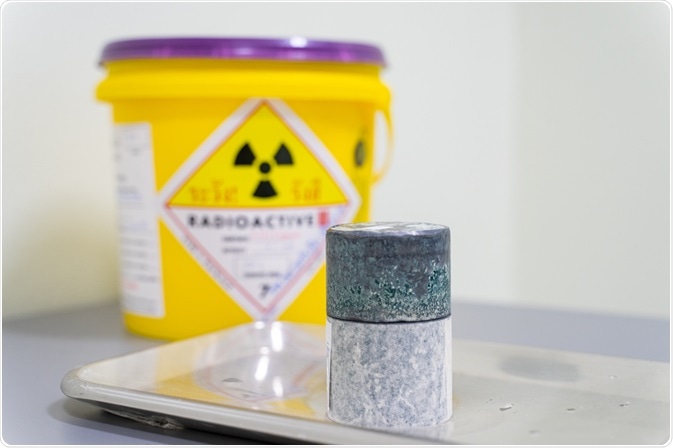Iodine-131 (or I-131) is a radioactive substance that emits both beta and gamma radiation and has a half-life of 8.03 days.

Image Credit: pang_oasis / Shutterstock
Sources of I-131
Under normal circumstances, there are low levels of I-131 present in the nuclear medicine units of hospitals, due to its use in some radiotherapy treatments. Patients that have been treated with radioactive iodine in the last three months will also have trace amounts of the substance.
I-131 is also produced in the process of nuclear fission, which accounts for the fact that it is present in and in the surround of nuclear power plants, including those used to make nuclear weapons. In fact, the majority of I-131 in the environment originates from releases from nuclear power plants and the production and testing of nuclear weapons.
Populations living in the surrounding areas of these sites may be exposed to radioactive iodine. Additionally, animals grazing in affected areas may be exposed and products such as milk that they produced can be contaminated. Milk from goats and sheep grazing in affected areas contains considerably higher levels of radioactive iodine than that of cows.
Factors for Harm
Individuals exposed to radioactive iodine are at increased risk of particular health conditions, such as cancer of the thyroid gland. The factors that can affect the level of harm associated with exposure include:
- Exposure route
- Age of individual at exposure
- Dose of exposure
- Pregnant or breastfeeding women
The risk is increased for young children due to the faster rate of growth. Pregnant women and breastfeeding mothers are often particularly concerned about the potentially compromised health of their children.
Individuals that have been exposed to radioactive iodine in the past are at an increased risk for the development of thyroid nodules, hypothyroidism and autoimmune thyroiditis. This risk remains elevated at least 40 years after exposure to the radioactive source.
Most tumors of the thyroid gland in exposed patients are benign. However, approximately 5-10% are malignant and may cause serious health outcomes.
Preventing Damage After Exposure
Individuals that have been exposed to a release of radioactive substances such as I-131 are usually concerned about their health resulting from the incident. It is common for them to experience psychological stress, which may lead to depression, anxiety and post-traumatic stress disorder.
Following a nuclear release, there is a need for timely, factual information with advice for affected population about the potential health risks. Additionally, actionable steps should be included to reduce the risk of serious damage from the incident. Targeted advice for pregnant women and new mothers should be incorporated.
At the time of exposure, administration of potassium iodide (KI) can reduce the uptake of I-131. Contaminated milk products can be converted to powdered milk, cheese or yogurt to increase the rate of decay and decrease the exposure of populations.
Patients that have been exposed to I-131 in the past should be encouraged to be regularly screened for changes in the thyroid gland, as early detection of abnormal changes is the best method of defense. The level of thyroid-stimulating hormone (TSH) should be monitored and if a nodule of the thyroid gland presents, a fine needle aspiration biopsy should be taken to determine if it is malignant.
Exposure to Americans during the Cold War
The highest recorded levels of 1-131 recorded in history occurred during the 1950s and 1960s in the USA. Children who consumed fresh milk that was contaminated with radioactive iodine, due to animals grazing in areas near ground testing of nuclear weapons were most affected.
References
Further Reading
Last Updated: Apr 8, 2021